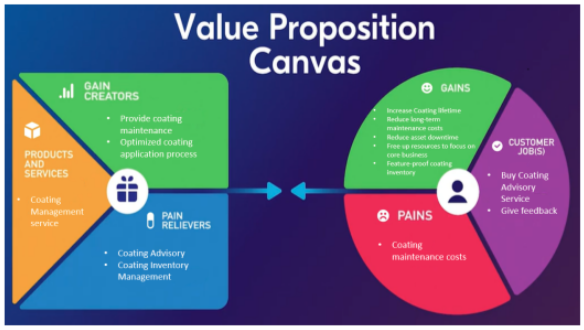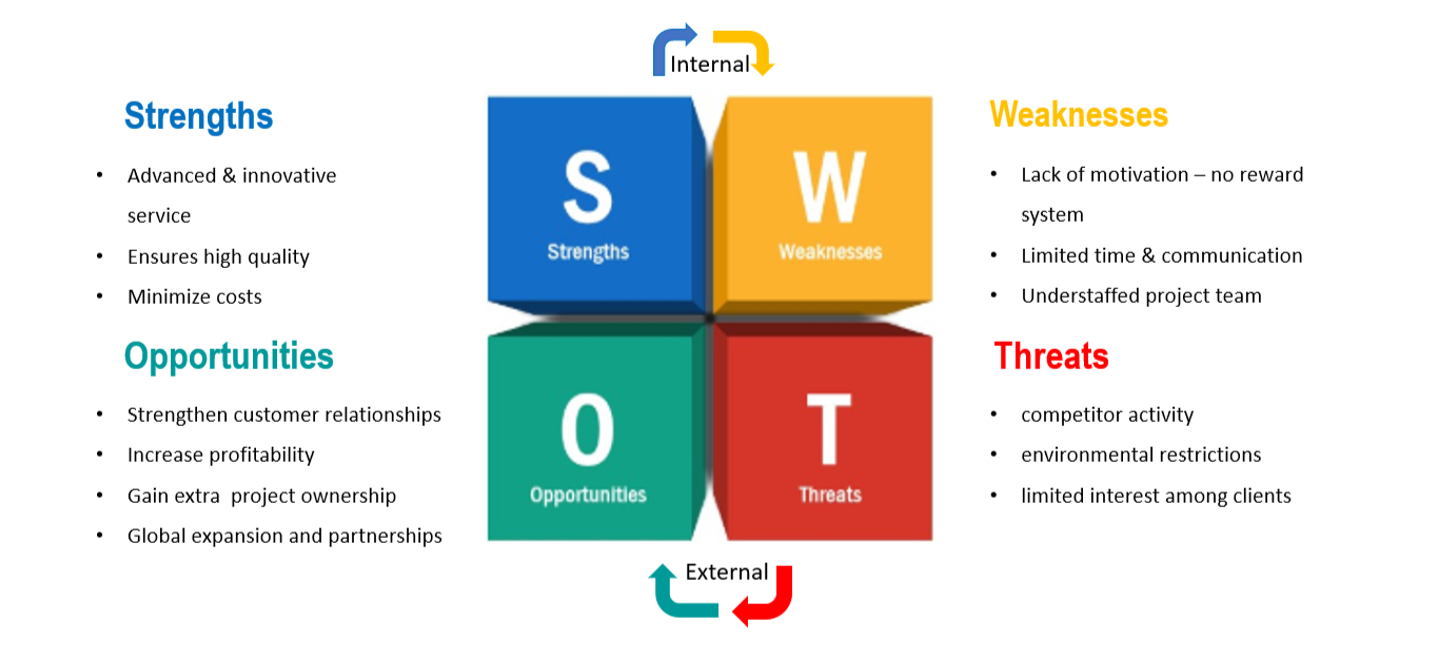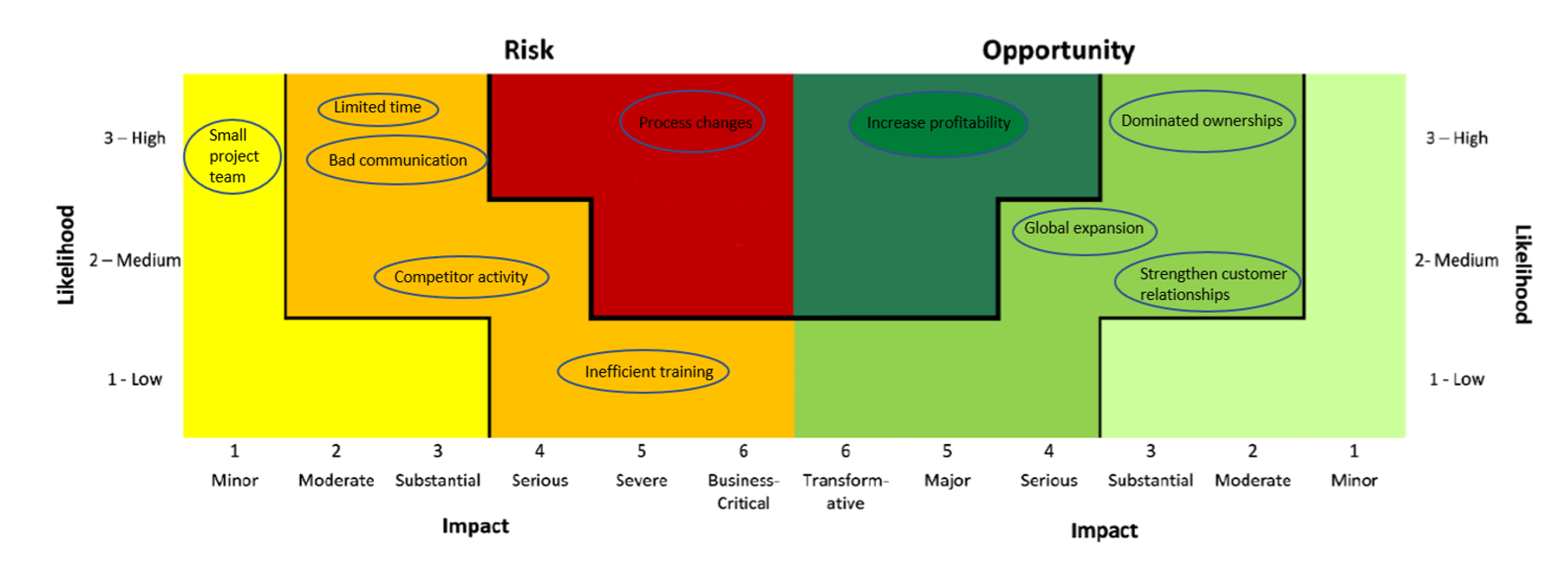Hempel Coating Management
(→Tools) |
(→Tools) |
||
| Line 77: | Line 77: | ||
'''SMART Goals''' | '''SMART Goals''' | ||
| − | + | ||
Smart acronym ensures that the company’s goals are clear and reachable. A goal should be clear and specific, in order to be able to focus the efforts or feel truly motivated to achieve it. It's important to have measurable goals to track the progress and stay motivated. Goals also need to be realistic and attainable to be successful. In other words, it should stretch team’s abilities but remain possible. Relevance is about ensuring that your goal matters to you, and that it also aligns with other relevant goals. Last, every goal needs a target date, to create a deadline to focus on and something to work toward. | Smart acronym ensures that the company’s goals are clear and reachable. A goal should be clear and specific, in order to be able to focus the efforts or feel truly motivated to achieve it. It's important to have measurable goals to track the progress and stay motivated. Goals also need to be realistic and attainable to be successful. In other words, it should stretch team’s abilities but remain possible. Relevance is about ensuring that your goal matters to you, and that it also aligns with other relevant goals. Last, every goal needs a target date, to create a deadline to focus on and something to work toward. | ||
[[File:82231230_460215198006634_1176306995943178240_n.png]] | [[File:82231230_460215198006634_1176306995943178240_n.png]] | ||
| Line 84: | Line 84: | ||
The above figure illustrates the SMART goals, as they have been implemented to the sub goals in Hempel Case. Extending the company’s portfolio to protective management is a service very specific, achievable and relevant. The project is time-based, and the success is also measurable by statistics. Creating coating training program fulfill the SMART goals criteria, as well. Being competitive and developing the best product is a specific and relevant goal, but it may be achieved in the far future [X**]. There is not a certain time point to finish it and it seems more difficult to be accomplished. Moreover, raising Hempel’s profits is not a time limited goal and may be successful in the near future [X*]. Each goal of the project appears to be clear and relevant enough to motivate and matters to everyone participated. | The above figure illustrates the SMART goals, as they have been implemented to the sub goals in Hempel Case. Extending the company’s portfolio to protective management is a service very specific, achievable and relevant. The project is time-based, and the success is also measurable by statistics. Creating coating training program fulfill the SMART goals criteria, as well. Being competitive and developing the best product is a specific and relevant goal, but it may be achieved in the far future [X**]. There is not a certain time point to finish it and it seems more difficult to be accomplished. Moreover, raising Hempel’s profits is not a time limited goal and may be successful in the near future [X*]. Each goal of the project appears to be clear and relevant enough to motivate and matters to everyone participated. | ||
| + | '''Stakeholder mapping matrix''' | ||
| + | |||
| + | The notion of stakeholders is of utmost importance in doing projects and that is the reason why stakeholder management is a key process in every single management methodology. “Stakeholders” are persons or organisations who are actively involved in a project or whose interests may be positively or negatively affected by the performance or completion of the project. So, it is important to identify and assess the stakeholders that are related with a project in order to understand the level of their influence and the interest they might have for the completion of the project. The stakeholders are categorised in three different groups: internal, external and customers/client companies. | ||
| + | |||
| + | Internal stakeholders can be divided further in two categories, downward and upward. Downward stakeholders could be the project team members and other departments of the organization that are working upon the project. In this specific project, downward stakeholders are the project team. the technical and communication department. Marketing department, Commercial strategy department and the technical reference group. They hold a critical role in the completion of the project because their position as employees might cause negative or positive effects on the performance of the project. Upward stakeholders are these that have the power, authority and are financing the project. In Hempel's case these are Project Owner, Board & Steering Committee and Project Sponsor as it is shown to the below stakeholder mapping matrix. | ||
| + | |||
| + | [[File:MAPMAT.PNG]] | ||
| + | |||
| + | ''' The double probability impact matrix (DPIM) ''' | ||
| + | |||
| + | Through risk assessment, evry company can estimate the probability of occurrence of each risk, evaluate their impact and develop the overall risk situation. The project management team have to prioritize therisks several times throughout the life cycle of the problem and adapt to changes. The project manager,after identifying the most important uncertain events that may occur, distinguishes them into risks and opportunities. | ||
| + | |||
| + | The double probability impact matrix illustrates the most significant occasions the company had to deal with during the development of a project. In Hempel's case, the area of senior management focus was about the changes and adjustments that occurred during this project, as well as the opportunity of increasing thetotal profits of the company. The project manager mentioned that throughout the life cycle of this casethey confronted several changes. Scope, timelines and name changed during the project procedure. At first, it was planned to develop a similar project with the one in marine coating service. However, it became clear during the process that there are important differences in the protective field and it was necessary to change many aspects during the project planning and scheduling. As it was mentioned above, the rise of company’s profits is a highly potential opportunity with major impact and that’s why it’s included inthe area of focus. The above mentioned are presented at the below figure. | ||
| + | [[File:DoubleopportunityMatrix.png]] | ||
Revision as of 19:20, 26 February 2020
Introduction
As part of Hempel’s newly formed service organization, a number of development projects of new services have been planned coupled with several operational upgrades. A foundational service offering is “coating advisory”. This service includes sending expert coating advisors to oversee surface preparation and coating application of the products. Initially, Hempel acquired two levels of coating advisory, Standard coating advisory, and Premium coating advisory. After collaborating with key customers, a third level was developed for the marine segment where the company took over the responsibility of planning the dry-docking projects. Drydocking projects are referring to fixed duration re-coatings of vessels, which takes place every five years according to regulatory requirements. In marine, this new service was called “Project Management”. Therefore, the scope of this project was to develop a similar third-tier service for the protective segments. By doing so, they offer more than premium coating advisory and they could provide more value and earn more per hour.
Tools
The iron triangle illustrates the relationship between cost, time and quality (TCQ). When planning a project, the project managers are highly advised to take into consideration these three parameters. TCQ model is considered to be a useful management tool to show management focus and measure any management success. The project manager has to have the proper knowledge regarding the relations between the constraints of TCQ and the right ones to get prioritized in their project.
Application of tool
On the hempen project, time and quality were the two constraints that were prioritized. Such prioritization helps the project team to make quick decisions and focus effort on what is most relevant. Quality is a very significant parameter since delivering trusted services and premium coating advisory are mainly implemented in this project. Time is also a highly influential factor in this case, as this specific concept had been attempted and failed in the past. Therefore, the Hempel case can be located in the middle of time and quality constraints.
Value Proposition Canvas
- Romina
As it is shown in Figure there are several reasons for the clients to invest in an advanced coating management service. The proactive nature of the optimized coating service provides to the customers the ability to avoid long-term maintenance costs that are related to accidents, environmental conditions, and other common problems. The accurate inspection that took place before the initiation of any project also ensures better quality for the final results and reduces asset downtime. So from the customers' point of view, it seems like an attractive offer. On the other side, the fact that competitors are providing a standard coating advisory service at the early stages of a project to their clients for free might have negative effects(pain creators) on customers’ preference, because in this case, they have to pay extra for this advanced coating management service. However, an important difference is that this service provides full inspection and maintenance coating management for a long period after the completion of a project and that is why it is differentiated from other coating advisory services.
Customer segment: The focus on the customer segment side is on why; why is there a need for project initiation?
Customer job(s): The customer job(s) assess what the customer wants to do, which actions or tasks does the customer or user want to perform. In the South Sudan case, the users have a very basic customer job in the accessibility of clean drinking water.
Pains: The pains tell which negative effects the user is experiencing for the status quo. This can be a result of competitors lacking the necessary capabilities to offer a proper product or service. It can also be a result of users not having access to any products or services to fulfill their customer job. The project manager must acknowledge these customer pains, in order to identify the benefits project outcomes need to incorporate. [1]
Gains: Unlike pains, gains are not factors that are clear for the user. These are factors that the user is not necessarily expecting of a product or service, but are extra benefits supplied. Gains are not essential for project success, but rather an area where project managers can differentiate their project outcomes. In the South Sudan case, the gains delivered came in the form of education in hygiene, local training of staff and clean toilet facilities. Instead of only providing clean drinking water, the consulting company provided extra features, which the company differentiates itself in the highly competitive market of consultancy.
Value proposition: From the customer segment side to the value proposition the focus changes from why to what and how; what will the project delivery and how will the project deliverables satisfy customer needs?
Products & services: Outlines the products and services the project outcome is built around.
Pain relievers: Pain relievers are ways of removing the customer/user’s pains. These deliverables are essential for user satisfaction. The pain relievers are not always in the form of products and services but can be features of these deliverables that solve customer/user pain of the status quo. Niras conducted construction work to create improved water wells for local communities in need as well as using local companies for maintenance for a sustainable solution.
Gain Creators: The gain creators are deliverables creating the extra gains for the customer/user. In the South Sudan case, this was enabled by creating education and training programs, spending extra resources to create extra value for the users.
SWOT Analysis
- Ian
Identification is the first step in uncertainty analysis. It is necessary to identify all possible risks and develop risk management by focusing attention where needed. It is also important to specify the objective of the project and identify the internal and external factors that are favorable and unfavorable to achieving that objective. SWOT tool is appropriate to implement the strengths and weaknesses that arise from within the company, as well as the opportunities and threats from external sources [6].
Figure 11: SWOT analysis Based on the information from the interviews a SWOt analysis was carried out. It seems that the main threat of the case is the competition that Hempel will have to face in the future, by expanding their portfolio into advanced coating management. As the project manager mentioned himself, there are several companies in this area that offer the service of coating management in other large companies and clients for free, and this occasion appears to be a threat. However, through this project, Hempel develops more premium coating advisory, including maintenance training and advanced services offered by charge. From another point of view, this differentiation can be identified as an opportunity to increase their profits and strengthen their customer relationships.
SMART Goals
Smart acronym ensures that the company’s goals are clear and reachable. A goal should be clear and specific, in order to be able to focus the efforts or feel truly motivated to achieve it. It's important to have measurable goals to track the progress and stay motivated. Goals also need to be realistic and attainable to be successful. In other words, it should stretch team’s abilities but remain possible. Relevance is about ensuring that your goal matters to you, and that it also aligns with other relevant goals. Last, every goal needs a target date, to create a deadline to focus on and something to work toward. File:82231230 460215198006634 1176306995943178240 n.png
The above figure illustrates the SMART goals, as they have been implemented to the sub goals in Hempel Case. Extending the company’s portfolio to protective management is a service very specific, achievable and relevant. The project is time-based, and the success is also measurable by statistics. Creating coating training program fulfill the SMART goals criteria, as well. Being competitive and developing the best product is a specific and relevant goal, but it may be achieved in the far future [X**]. There is not a certain time point to finish it and it seems more difficult to be accomplished. Moreover, raising Hempel’s profits is not a time limited goal and may be successful in the near future [X*]. Each goal of the project appears to be clear and relevant enough to motivate and matters to everyone participated.
Stakeholder mapping matrix
The notion of stakeholders is of utmost importance in doing projects and that is the reason why stakeholder management is a key process in every single management methodology. “Stakeholders” are persons or organisations who are actively involved in a project or whose interests may be positively or negatively affected by the performance or completion of the project. So, it is important to identify and assess the stakeholders that are related with a project in order to understand the level of their influence and the interest they might have for the completion of the project. The stakeholders are categorised in three different groups: internal, external and customers/client companies.
Internal stakeholders can be divided further in two categories, downward and upward. Downward stakeholders could be the project team members and other departments of the organization that are working upon the project. In this specific project, downward stakeholders are the project team. the technical and communication department. Marketing department, Commercial strategy department and the technical reference group. They hold a critical role in the completion of the project because their position as employees might cause negative or positive effects on the performance of the project. Upward stakeholders are these that have the power, authority and are financing the project. In Hempel's case these are Project Owner, Board & Steering Committee and Project Sponsor as it is shown to the below stakeholder mapping matrix.
The double probability impact matrix (DPIM)
Through risk assessment, evry company can estimate the probability of occurrence of each risk, evaluate their impact and develop the overall risk situation. The project management team have to prioritize therisks several times throughout the life cycle of the problem and adapt to changes. The project manager,after identifying the most important uncertain events that may occur, distinguishes them into risks and opportunities.
The double probability impact matrix illustrates the most significant occasions the company had to deal with during the development of a project. In Hempel's case, the area of senior management focus was about the changes and adjustments that occurred during this project, as well as the opportunity of increasing thetotal profits of the company. The project manager mentioned that throughout the life cycle of this casethey confronted several changes. Scope, timelines and name changed during the project procedure. At first, it was planned to develop a similar project with the one in marine coating service. However, it became clear during the process that there are important differences in the protective field and it was necessary to change many aspects during the project planning and scheduling. As it was mentioned above, the rise of company’s profits is a highly potential opportunity with major impact and that’s why it’s included inthe area of focus. The above mentioned are presented at the below figure.
Risk Assessment
- Dimitra
Conclusion
Cite error:
<ref> tags exist, but no <references/> tag was found


